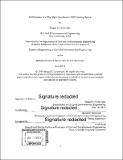Optimization of a fiber optic freshwater DOM sensing device
Author(s)
Cartwright, Abigail E.(Abigail Elaine)
Download1129584561-MIT.pdf (18.39Mb)
Other Contributors
Massachusetts Institute of Technology. Department of Civil and Environmental Engineering.
Advisor
Harold F. Hemond.
Terms of use
Metadata
Show full item recordAbstract
Fiber optical arrangements are useful for measurement of aquatic chemical species, especially in waters of high chemical concentrations. An optical fiber spectrofluorometer device known as the "Hammerhead" was developed in the Hemond lab in 2015 and improved in 2016 to measure concentrations of dissolved organic matter in water samples. The Hammerhead operates by detecting fluorescence, absorbance, and scattering of light within the water. However, inner shielding, particularly in high DOC concentrations, can lead to meaningless results. This project expands upon the earlier Hammerhead work by seeking the highest possible fluorescence signal from the Hammerhead. Experiments were run using a series of different geometric schemes for the Hammerhead optical fibers. Of the configurations tested, the narrowest spacing between excitation fiber and detector (0.076 inches from each fiber's tip to the center of the chamber) produced optimal results. This new configuration shortens the light path length and largely avoids inner shielding effects. The new design was then compared with a traditional flow cell water measurement device known as the LEDIF, using both fluorescein and humic acid substances. Comparing the signals for both instruments indicates that the Hammerhead fiber optic scheme is superior in detecting fluorescence measurements at high DOC concentrations; it produces a nearly linear response for fluorescence, while inner shielding hinders LEDIF results. In addition, comparing the limit of detection for both instruments indicates that the Hammerhead performs better than the LEDIF even independent of inner shielding effects, producing a signal nearly 10 times greater than the LEDIF in low DOC concentrations.
Description
Thesis: M. Eng., Massachusetts Institute of Technology, Department of Civil and Environmental Engineering, 2019 Cataloged from PDF version of thesis. Includes bibliographical references (page 27).
Date issued
2019Department
Massachusetts Institute of Technology. Department of Civil and Environmental EngineeringPublisher
Massachusetts Institute of Technology
Keywords
Civil and Environmental Engineering.